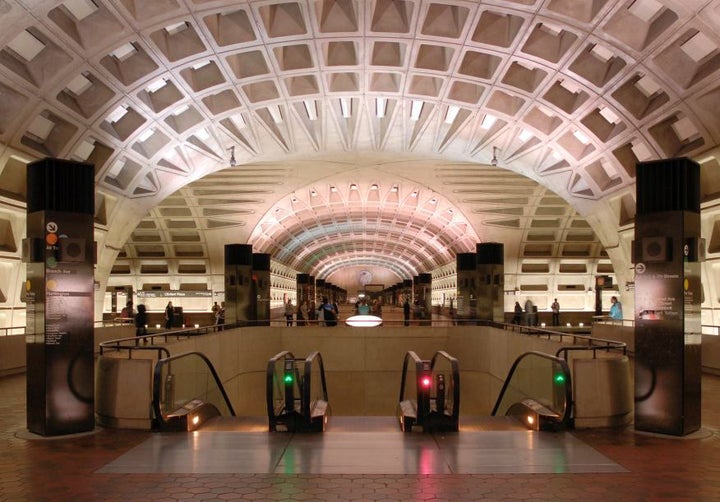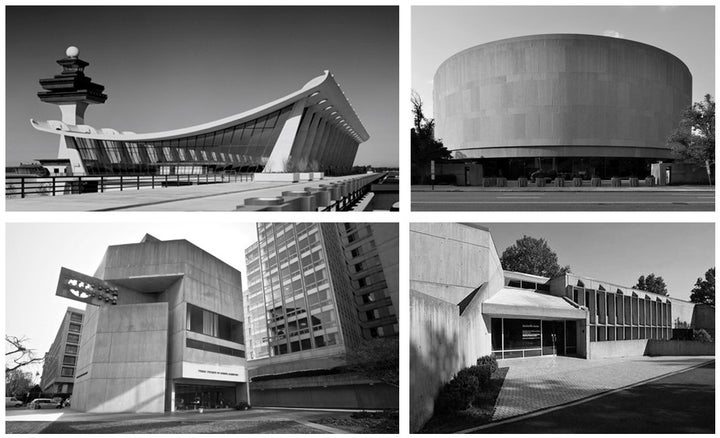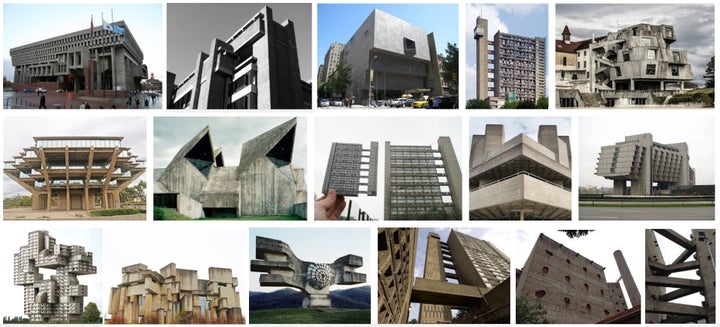The label may be limiting how we see the design of the capital subway stations.

The Washington Metro’s form, structure, and space surely relate much more to these historical models than they do to Brutalism. The vault geometry is reminiscent of the structural virtuosity in Antonio Gaudi’s catenary arches and vaults, and the coffers are shaped to be as efficient as possible with material and reduce the weight of the structure, a technique possibly influenced by the experimentation of Buckminster Fuller and Frei Otto, both widely known in the 1960s. By contrast, buildings characterized as “Brutalist” often are over-structured, because the rationalism of the early European approach morphed into idiosyncratic sculptural expression in the US—a “battered bunker” aesthetic of “fortress-like piles of gray concrete,” according to the Boston Globe. Louis Kahn bashed what he called “the muscular posturing of most Brutalism,” which the authors of Heroic call “more Marlboro man than Mad Men.”
In this view of Brutalism, it was fascinated with “weighty massiveness,” while Weese’s Metro is all lightness and lift, an effect that is evident even in his earliest concept sketches (which, incidentally, indicate no particular material or structure). The “airy and spacious” design, as the AIA described it in 2014, is markedly different from canonical Brutalist structures, which have more spatial complexity. The clarity of the Metro’s centering makes the space “navigable and understandable” (AIA), while at the Boston City Hall and especially the Rudolph building at Yale, space continually pivots, forcing diagonal views and paths, shifting perspectives to create a sense of movement and mystery. While some point to “repetition of a single element—say, Metro’s waffle-shaped ceilings” as a typical attribute of Brutalism, this doesn’t apply to many of the most noted examples, including the Rudolph, the Pei, or the exterior of Gordon Bunshaft’s Hirshhorn Museum, also in DC.
At most, the Washington Metro has a peripheral affiliation with Brutalism, mainly due to its material and age. Yet, the stations have been described as “landmarks of Brutalist design” and “emblematic of all the rules of Brutalist architecture,” and Hurley insists, “The Washington Metro is not a minor work of Brutalism.” If it is such a major example, why did no one identify it as such until recently? Zachary Schrag, author of The Great Society Subway: A History of the Washington Metro (2006), tells me that in his research he did not encounter the word in relation to the Metro in any formal architectural publication from the 1960s til his book was published. Online, I can find little or no evidence of the term applied to the Metro until the past decade, over 30 years after the first station opened and 40 years after it was designed.

Top: Dulles Airport, Hirshhorn Museum. Bottom: Third Church of Christ, Scientist, American Press Institute.
In 2007, the Metro appeared in “America’s Favorite Architecture,” the AIA’s survey of the 150 most popular buildings in the US. While the AIA makes no mention of Brutalism, Wikipedia’s entry on the survey identifies the Metro as “Brutalist,” and its page on Weese calls it “the only brutalist design to win a place” on the list. I can’t determine the dates and authors of these references, but otherwise I have found virtually no online references prior to 2009, when a few commenters began to use the appellation. One of the earliest instances occurred that summer in Greater Greater Washington—by none other than Matt Johnson, the same planner who kicked off the paint controversy this year: “Metro is widely known for its soaring, brutalist vaults” (8/24/09). (Capitalization comes and goes with the word.) References practically exploded in 2010, and by the time the Metro received the Twenty-five Year Award in 2014, the label had become fairly common—at least among a particular cadre of critics, editors, and journalists. To this day, with relatively few exceptions the identified writers who apply the term to the Metro apparently include only a small group of Washington-area residents: notably Johnson, Capps, Hurley, Madsen, Dan Reed in the Washingtonian, Michelle Goldchain in Curbed, and Katie Gerfen, who in her 2014 coverage of the AIA award for Architect magazine mentions the Metro’s “signature Brutalist vaults,” although the AIA itself did not use that designation.
What accounts for the prolonged delay, even among these writers? According to Google Ngram, which tracks words and phrases in print sources through the year 2008, use of the term Brutalism climbed steadily from 1950 to 1970, flatlined in the 70s and 80s, had a resurgence in the 90s, and peeked around 1997 (incidentally, the year Paul Rudolph died). In the past decade, the number of books published on Brutalism appears to exceed the total number published at any point before. As mid-century concrete buildings began reaching middle age, and many, including DC’s Third Church of Christ, Scientist, were being razed, preservationists took notice. “As more and more examples of classic Brutalism face demolition by neglect,” Madsen has said about his Brutalist Washington Map, “we hope that putting these examples of D.C.'s Brutalist architecture on the map will foster public appreciation that ensures their longevity.” Schrag observes, “If you want to get people to value a concrete bunker, you need to articulate its particular worth, and identifying it with a particular brand of modern architecture is one way to do that.”
Whatever the reason for the resurgence, as Brutalism was on the rise, the Washington Metro also was getting more attention, making the AIA 150 list in 2007 and receiving the 25-Year Award in 2014. The following year brought a flurry of media attention on the preservation of Brutalist buildings. Over the past decade, the coincidence of general interest in the movement and specific interest in the Metro brought the two together, and the project retroactively got a new label, half a century after the fact.

Google image search results for “Brutalist Architecture.” Upper left: Boston City Hall, Rudolph Building at Yale, Whitney Museum.
But does the shoe fit? Pasnik and Grimley demur: “I don’t think we’re in the position to evaluate the Metro and its classification,” suggesting that even some experts on Brutalism don’t immediately see an obvious alignment. Bruegmann is more decisive: “Certainly the Metro is not a good example of the Brutalist style [as it was understood in the 60s and 70s]. It did not come out of the same mindset as, say, Rudolph's building at Yale.” Susan Piedmont-Palladino, Director of the Washington-Alexandria Architecture Center (WAAC) and a curator at the National Building Museum (NBM) in DC, agrees: “I don't put Metro in the Brutalist category. Simply being made of concrete isn't sufficient to be labelled Brutalist.” She has lectured widely on Brutalism, and her 2010 NBM event arguably helped spur local interest.
Piedmont-Palladino sees the style as less Classical and more Gothic: “You want structure? I'll show you structure!” The British critic John Ruskin affectionately called Gothic architecture “rude and wild,” she says. “I would argue that's a pretty good description of Brutalist architecture.” Weese’s Metro design is anything but “rude and wild.” Even before the first station was completed, Bruegmann recounts, the Washington Post hailed its “serene kind of beauty.”
Art-historical shorthands can be helpful to guide us toward prevailing views of a work, but the best works invariably resist pigeonholing because they transcend particular movements or styles. As the late architect Michael Graves remarked, “labels have the negative value of making smaller boundaries.” During the 60s, when Brutalism was emergent, Walter Gropius complained about “the irrepressible urge of critics to classify contemporary movements [by] putting each neatly in a coffin with a style label on it.” In a 2013 essay, Pasnik and Grimley write that “the reduction of Brutalism to a stylistic label exclusively associated with concrete” has made it “a rhetorical catastrophe.”
During the paint debate this Spring, the US Commission on Fine Arts (CFA), which helped develop the Metro system, sent a letter to WMATA to express concern. It emphasized the “majestic” quality of the Metro stations, “now considered a masterpiece of modern design” and “some of the most important civic spaces in Washington.” The DC chapter of the AIA sent a similar letter. Neither mentions Brutalism, which remains an historical trend with many detractors that is vaguely defined at best and for which the Metro is not a perfect example.
Champions of Weese’s design might be more effective in appealing for better upkeep if they portray it in the most expansive terms possible, as do the CFA, the national AIA, and the local AIA. As one of the 150 most popular structures in the country and one of fewer than 50 buildings to win the Twenty-five Year Award, the Washington Metro is so much bigger than Brutalism.
Postscript: In response to this article, BrutalistDC added a helpful definition, although some of the criteria included (e.g., structural innovation) are debatable. Also after publication, in a fascinating post, Zachary Schrag disagreed with Robert Bruegmann’s view of Harry Weese’s attitude toward concrete, pointing to quotations from Weese in 1967 and 1975 emphasizing the architect’s desire not to cover the concrete with other materials. He also notes that Gordon Bunshaft intended the Hirshhorn Museum to be sheathed in travertine.
